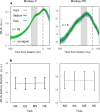Visual salience of the stop signal affects the neuronal dynamics of controlled inhibition
- PMID: 30250230
- PMCID: PMC6155270
- DOI: 10.1038/s41598-018-32669-8
Visual salience of the stop signal affects the neuronal dynamics of controlled inhibition
Abstract
The voluntary control of movement is often tested by using the countermanding, or stop-signal task that sporadically requires the suppression of a movement in response to an incoming stop-signal. Neurophysiological recordings in monkeys engaged in the countermanding task have shown that dorsal premotor cortex (PMd) is implicated in movement control. An open question is whether and how the perceptual demands inherent the stop-signal affects inhibitory performance and their underlying neuronal correlates. To this aim we recorded multi-unit activity (MUA) from the PMd of two male monkeys performing a countermanding task in which the salience of the stop-signals was modulated. Consistently to what has been observed in humans, we found that less salient stimuli worsened the inhibitory performance. At the neuronal level, these behavioral results were subtended by the following modulations: when the stop-signal was not noticeable compared to the salient condition the preparatory neuronal activity in PMd started to be affected later and with a less sharp dynamic. This neuronal pattern is probably the consequence of a less efficient inhibitory command useful to interrupt the neural dynamic that supports movement generation in PMd.
Conflict of interest statement
The authors declare no competing interests.
Figures




Similar articles
-
Neuronal Activity in the Premotor Cortex of Monkeys Reflects Both Cue Salience and Motivation for Action Generation and Inhibition.J Neurosci. 2021 Sep 8;41(36):7591-7606. doi: 10.1523/JNEUROSCI.0641-20.2021. Epub 2021 Jul 30. J Neurosci. 2021. PMID: 34330772 Free PMC article.
-
Neural correlates of cognitive control of reaching movements in the dorsal premotor cortex of rhesus monkeys.J Neurophysiol. 2011 Sep;106(3):1454-66. doi: 10.1152/jn.00995.2010. Epub 2011 Jun 22. J Neurophysiol. 2011. PMID: 21697448
-
Proactive inhibitory control and attractor dynamics in countermanding action: a spiking neural circuit model.J Neurosci. 2009 Jul 15;29(28):9059-71. doi: 10.1523/JNEUROSCI.6164-08.2009. J Neurosci. 2009. PMID: 19605643 Free PMC article.
-
Neural control of behavior: countermanding eye movements.Psychol Res. 2000;63(3-4):299-307. doi: 10.1007/s004269900008. Psychol Res. 2000. PMID: 11004883 Review.
-
Useful signals from motor cortex.J Physiol. 2007 Mar 15;579(Pt 3):581-601. doi: 10.1113/jphysiol.2006.126698. Epub 2007 Jan 25. J Physiol. 2007. PMID: 17255162 Free PMC article. Review.
Cited by
-
A neurocomputational theory of action regulation predicts motor behavior in neurotypical individuals and patients with Parkinson's disease.PLoS Comput Biol. 2022 Nov 17;18(11):e1010111. doi: 10.1371/journal.pcbi.1010111. eCollection 2022 Nov. PLoS Comput Biol. 2022. PMID: 36395336 Free PMC article.
-
Towards real-world generalizability of a circuit for action-stopping.Nat Rev Neurosci. 2021 Sep;22(9):538-552. doi: 10.1038/s41583-021-00485-1. Epub 2021 Jul 29. Nat Rev Neurosci. 2021. PMID: 34326532 Free PMC article. Review.
-
Attentional spatial cueing of the stop-signal affects the ability to suppress behavioural responses.Exp Brain Res. 2024 Jun;242(6):1429-1438. doi: 10.1007/s00221-024-06825-8. Epub 2024 Apr 23. Exp Brain Res. 2024. PMID: 38652274 Free PMC article.
-
Reward prospect affects strategic adjustments in stop signal task.Front Psychol. 2023 Mar 17;14:1125066. doi: 10.3389/fpsyg.2023.1125066. eCollection 2023. Front Psychol. 2023. PMID: 37008850 Free PMC article.
-
Efficacy of inhibitory control depends on procrastination and deceleration in saccade planning.Exp Brain Res. 2020 Oct;238(10):2417-2432. doi: 10.1007/s00221-020-05901-z. Epub 2020 Aug 9. Exp Brain Res. 2020. PMID: 32776172
References
MeSH terms
LinkOut - more resources
Full Text Sources
Other Literature Sources

